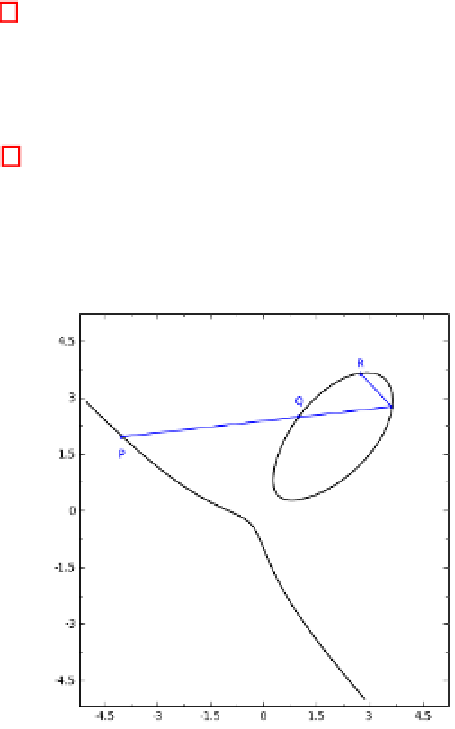Cryptography Reference
In-Depth Information
By Theorem 1, we can know the geometric interpretation of the group law on
Hessian curves.
Suppose
P, Q
are two points on a Hessian curve. The sum
R
,of
P
and
Q
,
is defined as follows. First draw a line through
P
and
Q
which intersects the
Hessian curve at a third point. Then R is the reflection of this point about the
line
y
=
x
. Fig. 1 depicts the addition on
x
3
+
y
3
+1=7
xy
over real field.
The double
R
, of P, is defined as follows. First draw the tangent line to the
curve at
P
. The line intersects the curve at a second point. Then
R
is the
reflection of this point about the line
y
=
x
.
Fig. 1.
Point addition on
x
3
+
y
3
+1=7
xy
over
R
4
Formulas for Pairings on Hessian Curves
Similarly to Eq. (1), using Theorem 1, we can prove the relation
f
i
+
j,P
=
f
i,P
·
f
j,P
·
g
iP,jP
on Hessian curves. This means pairings on Hessian curves can be computed by
Miller's algorithm [17].
In most cryptographic protocols,
P
canbechosensuchthat
<P >
is the
unique subgroup of order
r
in
H
(
F
p
). Suppose the embedding degree
k
is even,
then the field extension
F
p
k
is usually constructed via a quadratic subfield as
F
p
k/
2
(
α
), with
α
2
F
p
k
=
=
δ
∈
F
p
k/
2
.Since
k
is the smallest positive integer
(
p
k
1), it follows that (
p
k
1)
/r
is a multiple of
p
u
such that
r
|
−
−
−
1forsome
F
p
u
proper divisor
u
of
k
. So all elements of
map to 1 when raised to the power
(
p
k
1)
/r
.
Without loss of generality, we suppose
d
−
∈
F
p
k/
2
, and select
a
∈
F
p
k/
2
ran-
such that (
a
+
bα
)
3
+(
a
bα
)
3
+1=
domly. Repeat
a
=
a
+1until
∃
b
∈
F
p
k/
2
−



Search WWH ::

Custom Search